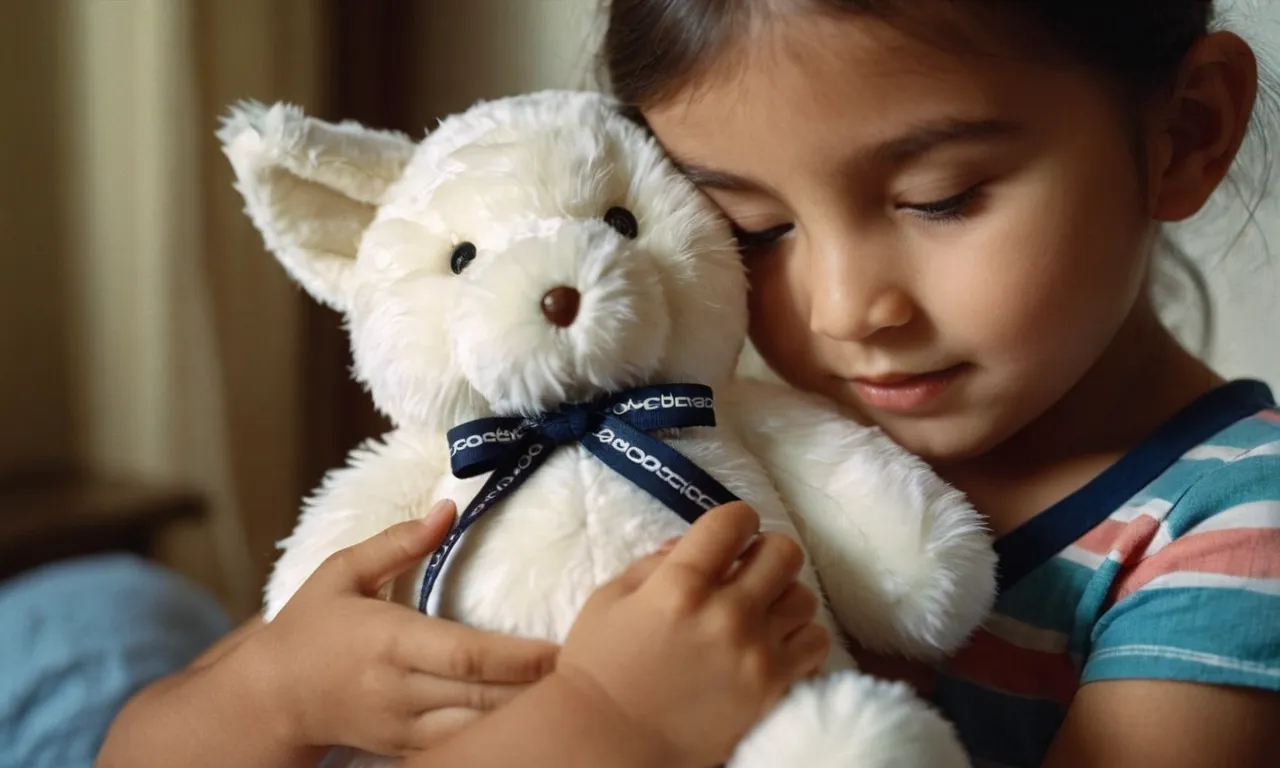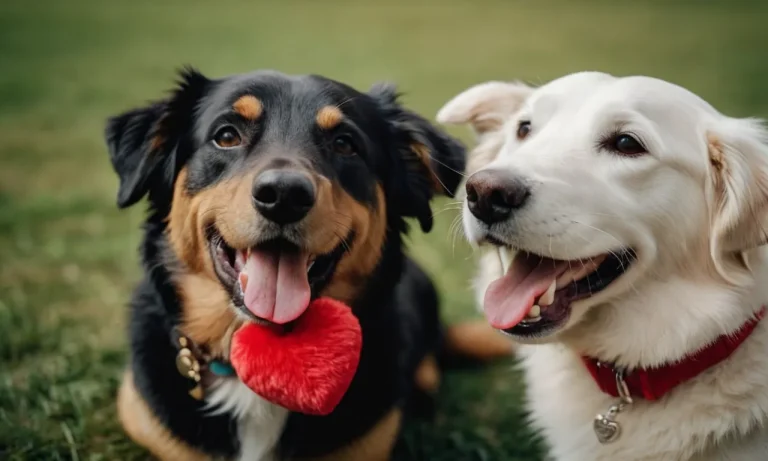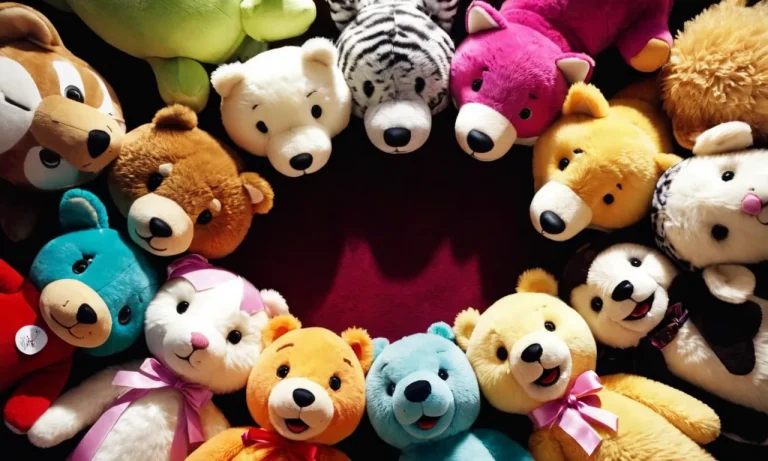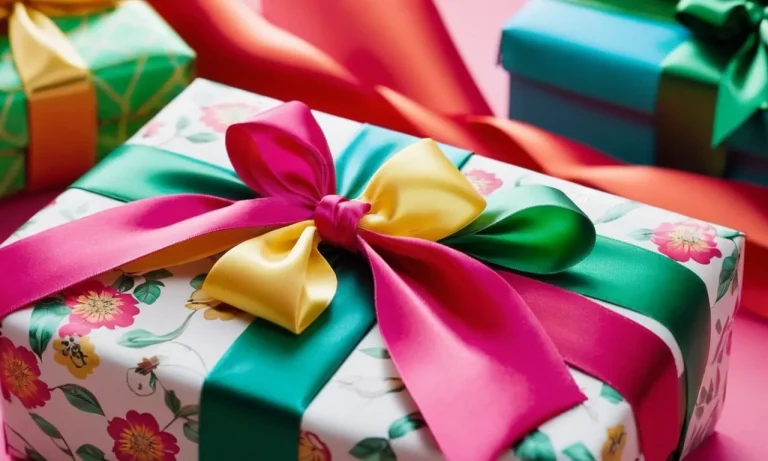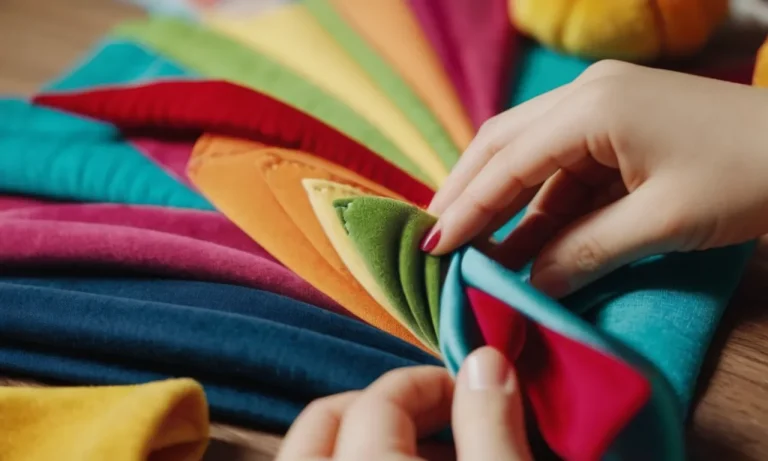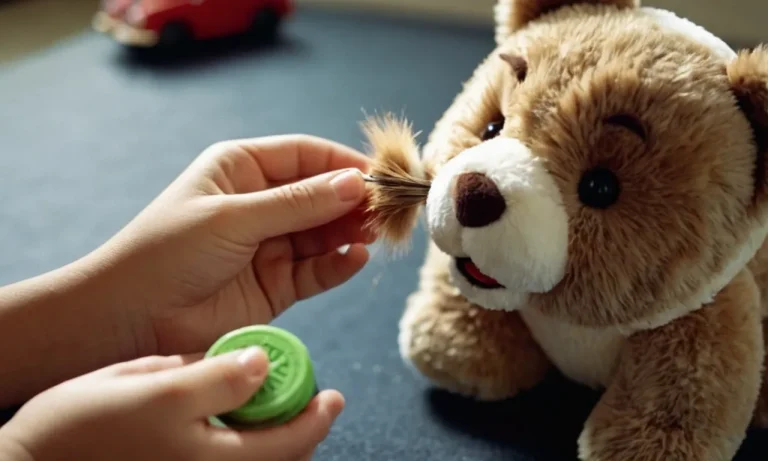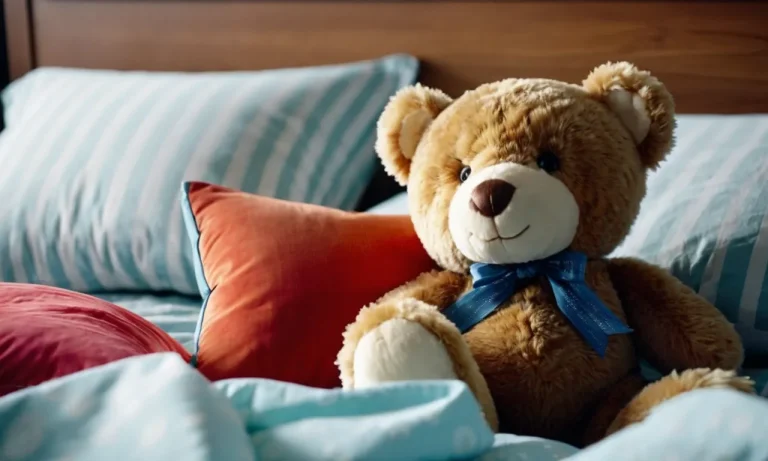Stuffed animals hold a special place in many people’s hearts. That beloved teddy bear you’ve had since childhood or the adorable plush puppy you won at the fair – they contain nostalgic meaning and comfort.
Naturally, you want to take good care of your stuffed friends to preserve the memories and keep them looking their cuddly best for years to come.
If you’re short on time, here’s a quick answer to your question: To properly care for a stuffed animal, regularly surface-clean it, spot treat any stains, wash when significantly soiled by hand or on the gentle cycle in a garment bag, air dry thoroughly, and store properly to prevent damage from light, pests, and environmental contaminants like cigarette smoke.
In this comprehensive guide, we will cover everything you need to know about cleaning and caring for plush toys of all types and materials. You’ll learn about:
Daily and Weekly Stuffed Animal Care
Regular Dusting and Inspection
To keep your stuffed animals looking their cuddliest, it’s important to dust and inspect them on a regular basis. Experts recommend quickly going over them with a lint roller or soft brush at least once a week to remove any dust or debris that may have accumulated.
As you dust, check for signs of wear, damage, or pests:
- Examine seams and stitching for loose threads or small holes.
- Feel the stuffing inside to ensure it hasn’t become lumpy or uneven.
- Inspect for stains, discoloration, or suspicious tiny spots that could indicate pests like carpet beetles.
If you notice any damage or insects, address issues right away by spot cleaning, sewing repairs, treating for pests, or even hiring a specialty stuffed animal restoration company if the damage is severe.
Spot Treating Minor Stains
Dealing with stains quickly is key to preventing permanent discoloration or damage. For small stains, spot clean gently using one of these methods:
- Dampen a clean white cloth with plain water or a very mild laundry detergent solution. Gently dab and blot the stained area, taking care not to oversaturate the stuffing inside.
- Use a clean pencil eraser to lightly rub stain spots on fabrics like cotton or canvas.
- For stubborn stains, mix a solution of lukewarm water with 1-2 drops of white vinegar or dish soap. Dip the corner of a cloth into solution and gently blot the stain.
No matter what cleaning method you use, avoid harsh scrubbing and always blot dry the area with a clean, absorbent cloth afterwards. Let your stuffed friend fully air dry for 24 hours before resuming cuddles!
Occasional Stuffed Toy Cleaning
Hand Washing
For a quick clean, hand washing is often the best method for cleaning your stuffed animals. Fill up your sink or a large bowl with lukewarm water and add a small amount of mild laundry detergent, making sure to read the instructions carefully.
Gently scrub the stuffed animal with your hands, paying special attention to any visibly dirty areas. Make sure not to submerge any electronic parts. Rinse thoroughly afterwards to remove all traces of soap. Allow to air dry completely before storing.
This easy cleaning method keeps stuffed animals fresh between deeper cleanings.
Machine Washing
When it’s time for a deeper clean, many stuffed animals are safe to wash in the washing machine. First, brush off any loose dirt or debris from the stuffed animal. Check the toy’s tag before washing and follow any care instructions provided.
Choose a delicate wash cycle with cold water, and wash the stuffed toy alone or with other colorfast stuffed animals to prevent color transfer or damage. Use a small amount of gentle laundry detergent, ideally one marketed for babies, children, or delicate fabrics.
Avoid scented detergents that could trigger allergies or irritate sensitive skin. After the wash cycle, either allow to air dry fully, or put the stuffed animal in the dryer on a no- or very low-heat delicate setting, checking frequently to prevent over-drying.
Drying
Proper drying helps preserve your stuffed toys after washing. Air drying is best to protect a stuffed animal’s shape and surface textures. Lay it flat on a towel in a well-ventilated area out of direct sunlight.
Reshape or restuff areas like the head or limbs if needed while drying so they retain their form. For toys that aren’t prone to matting, storing in front of a fan turned on low can speed up drying time. If putting stuffed animals in the dryer after washing, use the no- or delicate low-heat setting.
Check them frequently and remove before totally dry to avoid damage from over-drying. Avoid hang drying stuffed toys; the weight can cause uneven stretching.
Brushing and Grooming
Regular brushing and grooming keeps stuffed animals’ faux fur or textured fabrics looking clean, soft and tidy. Brush gently using a clean, soft-bristled brush meant for delicate fabrics. Carefully work out any dust, dirt or loose fibers caught in the fur. Avoid harsh scrubbing.
For plush toys with longer fur or shaggy textures, use a slicker brush gently specifically made for pet grooming. Check for any matted areas and loose threads you can clip off with child-safe scissors. Small stains can often be gently dabbed away using a barely-damp soft cloth without fully washing.
Proper brushing prevents the need for frequent whole washes.
Deodorizing and Disinfecting
Stuffed animals can pick up odors overtime. Luckily, quick household methods can freshen them up. Place toys in a sealable bag or bin with baking soda for a couple days to absorb odors, or sprinkle some inside before sealing and shaking gently to distribute.
Other odor-eliminating products like charcoal bags can also be used this way. For quick cleaning, spritz lightly with vinegar and allow to fully air dry to kill bacteria causing odors. Disinfect by spritzing with rubbing alcohol in a ventilated area.
Check first on a small hidden area that the rubbing alcohol does not affect color or damage any fabrics. With some occasional freshening and spot cleaning methods between deeper cleanings, stuffed animals will stay cleaner for longer.
| Cleaning Method | When to Use | Pros | Cons |
|---|---|---|---|
| Hand Washing | Lightly soiled toys needing a quick refresh | Gentle; allows thorough spot cleaning | Time-consuming for large collections; doesn’t sanitize |
| Machine Washing | Heavily soiled toys needing a deeper clean | Cleans thoroughly; convenient for many toys | Risk of damage if instructions aren’t followed |
| Brushing/Grooming | Frequent upkeep for fabrics prone to matting/dust | Prevents over-washing; removes surface dirt | Not suitable for highly soiled toys |
By understanding the best cleaning method for your stuffed toys’ materials and degree of soiling, you can keep them looking like new for years to come. With some occasional attention, they’ll stay safe, clean and ready for playtime, collecting, travel or display.
Proper Stuffed Animal Storage and Display
Location – Away from Sun, Smoke, and Pests
When choosing a location to store or display stuffed animals, it’s important to keep them away from environmental elements that could cause damage over time. Direct sunlight, smoke, and pests like insects or rodents can all deteriorate the fabrics, stuffing, and accessories on a stuffed animal.
Find an indoor spot that gets little to no direct sun exposure. Attics, basements, and garages may allow more exposure to pests or temperature fluctuations, so try display cabinets, bookcases, or shelves in climate-controlled living spaces instead.
Dorm rooms and kids’ bedrooms often provide great stuffed animal habitat if positioned thoughtfully on beds, desks, dressers, or shelves.
Using a Clear Plastic Storage Bin
For stuffed animals not currently on display, transparent plastic storage bins make ideal homes. They allow you to easily view your collection while keeping it clean and protected.
Look for bins that seal tightly to prevent dust buildup inside. Avoid bins prone to static cling that could attract hair, lint, and fibers. Line them with clean cloth or acid-free tissue paper first for an extra buffer between hard plastic and soft stuffies.
Placing Stuffing Inside to Retain Shape
To help stuffed animals hold their shape in storage, fill them out with extra stuffing or acid-free tissue paper before sealing them away. Lightly fill out head, arms, legs, and torso areas that tend to flatten or deform over time.
Be careful not to overstuff, as too much pressure can weaken seams. Check on them once in a while and refresh stuffing if needed. For rarer collectibles, customized museum-grade supports may be worthwhile long-term investments.
Preventing Dust Buildup
Despite best efforts, some amount of dust or lint is inevitable around fabrics over time. Gently wipe stuffed animals with a lint roller or soft brush to remove superficial buildup every so often. Baby wipes or slightly damp cloths can tackle surface grime if done delicately.
Avoid harsh cleaners, submerging in water, or machine washing unless the manufacturer explicitly allows it. Consult care labels for specifics. With vintage or homemade stuffies, take extra caution and spot clean gently if needed.
Considerations for Flocking, Appliques, and Other Special Materials
Unique stuffed animals may have coatings like flocked fibers or extra decorations. Flocking tends to be delicate; avoid handling these stuffies roughly or storing items on top of them which could cause crushing or transfers. Appliques could loosen over time as glues and stitches age.
Inspect special features like glass eyes, wires, or noisemakers for damage periodically. Document any existing flaws with photos so you don’t misattribute new issues later. Prioritize rarer varieties for more conservative storage and handling when practical.
When to Seek Professional Help for Stuffed Toy Care
Significant Staining
If your beloved stuffed animal has significant staining that you have been unable to remove through regular cleaning methods, it may be time to seek professional help. Stains like food, dirt, ink, or even mold can often be difficult to tackle on your own.
A professional stuffed animal cleaner or restorer that specializes in toy repair may have access to stronger cleaning solutions and techniques that can salvage your toy.
Torn Seams or Damage
Got a stuffed buddy with a major rip or tear? While minor holes can sometimes be fixed at home with needle and thread, significant damage like large tears, missing limbs or stuffing coming out warrants calling in an expert.
Professionals have the right tools, materials and skills to assess damage and determine the best repair approach whether that involves restitching seams or even full reconstruction in extreme cases.
Pest Infestations
Nothing spoils stuffed toy fun faster than bugs! If you suspect your plush pal has picked up unwanted critter hitchhikers like carpet beetles or bed bugs, stop snuggling them immediately and seek professional pest control and cleaning right away.
Failing to fully eliminate infestations can allow the pests to spread leading to costly home fumigation down the road.
Smoke Damage
Smoke from fires can permeate fabrics and be challenging to remove at home. Additionally, smoked-damaged toys may contain toxic residues you do not want your child exposed to. Professionals use techniques like ozone treatment to fully restore smoke-damaged stuffed animals, neutralize odors and ensure they are safe for playtime.
Serious smoke damage may be beyond salvage so an expert evaluation is key.
Taxidermy Specimens
Stuffed animals that contain real fur, feathers, horns or bones like antique toys or taxidermy mounts require specialized care from trained preservation experts when cleaning or repair is needed. Proper handling of fragile organic materials as well as compliance with regulations around endangered species are crucial factors to consider.
Knowing when to seek outside help ensures your cherished stuffed friends get the best care possible so you can enjoy them for years to come. Check out the American Academy of Cleaning History’s stuffed animal cleaner directory at https://www.cleaninghistory.org to find a professional in your area.
Caring for Stuffed Animals by Material Type
Plush Fur Fabrics
Plush fur fabrics like faux fur or velvet pile are common materials for stuffed animals. The soft, cozy piles are part of the stuffed animal’s charm! To care for plush furry friends: use a fabric lint brush weekly to lift dust and debris trapped in the fibers.
Spot clean stains immediately with a small amount of mild detergent and a damp white cloth. Allow to fully air dry before more cuddles! Gentle machine washing may be needed every few months – just be sure to place your pal in a laundry bag first to prevent damage in the washer.
Air fluff drying is best.
Vinyl and Plastic
Vinyl and plastic stuffed animals can withstand frequent squeezes and washes more so than fabric varieties. Over time though, plastic surfaces may get sticky with residue. Mix a solution of warm water and mild dish soap, dip a soft cloth into it, wring out excess moisture, and gently wipe plastic areas needing a refresh.
Rinse the same cloth with plain water, wring out, and wipe again to remove any soapiness. Allow to fully air dry. For seriously sticky situations, try using rubbing alcohol instead of soap, followed by a plain water wipe down.
Cotton
Cotton is a popular stuffed animal filling and fabric choice for its softness and durability. Routinely use a lint roller on cotton stuffed pals to get rid of environmental dust and particles. For washing guidance, first check any tags for recommendations.
In general, machine washing on a delicate cycle with mild detergent is safe for cotton stuffed animals. Be sure to air dry thoroughly before giving your snuggly friend more hugs! If just spot cleaning is needed, gently dab problem areas with mild soap and water using a white cloth.
Fully air dry as well.
Wool
Wool stuffed animals require extra special care since wool fabric is prone to shrinking if agitated too much. Use a lint brush once a week to remove superficial dust and debris. To wash wool stuffed pals, fill a large sink or basin with lukewarm water and add a tiny amount of mild liquid soap (no more than a teaspoon per gallon of water).
Fully submerge the stuffed animal and gently move it around to release dirt. Do not wring, scrub, or twist the item. Drain the dirty water and refill basin with plain lukewarm water for rinsing. Drain again and wrap stuffed animal in a clean towel to absorb moisture, gently pressing but again being cautious not to twist or wring.
Air dry the stuffed pal thoroughly before the next cuddle session! Spot cleaning wool with a damp white cloth is best when possible instead of full washing.
Silk
Silky stuffed animals require the most delicate care due to the finicky nature of silk fabric. Like wool pal care, avoid fully submerging in water if possible. Use a lint roller once per week to remove surface debris. Spot clean stains by dabbing gently with a damp white cloth and plain water first.
If needed for tougher stains, mix a very small amount of mild laundry detergent (1/4 teaspoon or less per cup of water) into some lukewarm water and dip the cloth into the solution before dabbing. Avoid vigorous scrubbing at all costs!
Allow silk stuffed pals to air dry completely before further handling and storage.
Leather
Leather stuffed animals generally represent animal hides, so proper conditioning keeps the material supple just like caring for a leather jacket. About once a month, apply leather conditioner by massaging a thin layer into the surface using a clean, soft cloth. Avoid over-saturating the material.
Simply rub in enough conditioner that it gets absorbed. Wipe away any excess. Allow the leather time to soak up the moisturizing oils before cuddling up again! For cleaning, dust routinely with a lint roller. Spot clean as needed gently using a damp cloth dabbed in mild sudsy water.
Dry with a fresh cloth. Deep conditioning maintains leather’s flexibility and minimizes cracking over time.
Conclusion
We hope this stuffed animal care guide empowers you to properly clean and preserve your beloved plush pals. By implementing regular maintenance along with proper storage, display, and cleaning when necessary, your stuffed critters will remain in tip-top condition while retaining their nostalgic and sentimental value.
Most importantly, be sure to handle your stuffed animals gently during cleaning. Check labels for washing instructions when possible. Test cleaning products on small hidden areas first and discontinue use if any damage occurs.
With some basic care and caution, your snuggly friends can remain safe and sound for many years of cuddles to come!

